
- •Preface
- •About This Book
- •Acknowledgments
- •Contents at a Glance
- •Contents
- •Relaxing at the Beach
- •Dressing the Scene
- •Animating Motion
- •Rendering the Final Animation
- •Summary
- •The Interface Elements
- •Using the Menus
- •Using the Toolbars
- •Using the Viewports
- •Using the Command Panel
- •Using the Lower Interface Bar Controls
- •Interacting with the Interface
- •Getting Help
- •Summary
- •Understanding 3D Space
- •Using the Viewport Navigation Controls
- •Configuring the Viewports
- •Working with Viewport Backgrounds
- •Summary
- •Working with Max Scene Files
- •Setting File Preferences
- •Importing and Exporting
- •Referencing External Objects
- •Using the File Utilities
- •Accessing File Information
- •Summary
- •Customizing Modify and Utility Panel Buttons
- •Working with Custom Interfaces
- •Configuring Paths
- •Selecting System Units
- •Setting Preferences
- •Summary
- •Creating Primitive Objects
- •Exploring the Primitive Object Types
- •Summary
- •Selecting Objects
- •Setting Object Properties
- •Hiding and Freezing Objects
- •Using Layers
- •Summary
- •Cloning Objects
- •Understanding Cloning Options
- •Mirroring Objects
- •Cloning over Time
- •Spacing Cloned Objects
- •Creating Arrays of Objects
- •Summary
- •Working with Groups
- •Building Assemblies
- •Building Links between Objects
- •Displaying Links and Hierarchies
- •Working with Linked Objects
- •Summary
- •Using the Schematic View Window
- •Working with Hierarchies
- •Setting Schematic View Preferences
- •Using List Views
- •Summary
- •Working with the Transformation Tools
- •Using Pivot Points
- •Using the Align Commands
- •Using Grids
- •Using Snap Options
- •Summary
- •Exploring the Modifier Stack
- •Exploring Modifier Types
- •Summary
- •Exploring the Modeling Types
- •Working with Subobjects
- •Modeling Helpers
- •Summary
- •Drawing in 2D
- •Editing Splines
- •Using Spline Modifiers
- •Summary
- •Creating Editable Mesh and Poly Objects
- •Editing Mesh Objects
- •Editing Poly Objects
- •Using Mesh Editing Modifiers
- •Summary
- •Introducing Patch Grids
- •Editing Patches
- •Using Modifiers on Patch Objects
- •Summary
- •Creating NURBS Curves and Surfaces
- •Editing NURBS
- •Working with NURBS
- •Summary
- •Morphing Objects
- •Creating Conform Objects
- •Creating a ShapeMerge Object
- •Creating a Terrain Object
- •Using the Mesher Object
- •Working with BlobMesh Objects
- •Creating a Scatter Object
- •Creating Connect Objects
- •Modeling with Boolean Objects
- •Creating a Loft Object
- •Summary
- •Understanding the Various Particle Systems
- •Creating a Particle System
- •Using the Spray and Snow Particle Systems
- •Using the Super Spray Particle System
- •Using the Blizzard Particle System
- •Using the PArray Particle System
- •Using the PCloud Particle System
- •Using Particle System Maps
- •Controlling Particles with Particle Flow
- •Summary
- •Understanding Material Properties
- •Working with the Material Editor
- •Using the Material/Map Browser
- •Using the Material/Map Navigator
- •Summary
- •Using the Standard Material
- •Using Shading Types
- •Accessing Other Parameters
- •Using External Tools
- •Summary
- •Using Compound Materials
- •Using Raytrace Materials
- •Using the Matte/Shadow Material
- •Using the DirectX 9 Shader
- •Applying Multiple Materials
- •Material Modifiers
- •Summary
- •Understanding Maps
- •Understanding Material Map Types
- •Using the Maps Rollout
- •Using the Map Path Utility
- •Using Map Instances
- •Summary
- •Mapping Modifiers
- •Using the Unwrap UVW modifier
- •Summary
- •Working with Cameras
- •Setting Camera Parameters
- •Summary
- •Using the Camera Tracker Utility
- •Summary
- •Using Multi-Pass Cameras
- •Creating Multi-Pass Camera Effects
- •Summary
- •Understanding the Basics of Lighting
- •Getting to Know the Light Types
- •Creating and Positioning Light Objects
- •Viewing a Scene from a Light
- •Altering Light Parameters
- •Working with Photometric Lights
- •Using the Sunlight and Daylight Systems
- •Using Volume Lights
- •Summary
- •Selecting Advanced Lighting
- •Using Local Advanced Lighting Settings
- •Tutorial: Excluding objects from light tracing
- •Summary
- •Understanding Radiosity
- •Using Local and Global Advanced Lighting Settings
- •Working with Advanced Lighting Materials
- •Using Lighting Analysis
- •Summary
- •Using the Time Controls
- •Working with Keys
- •Using the Track Bar
- •Viewing and Editing Key Values
- •Using the Motion Panel
- •Using Ghosting
- •Animating Objects
- •Working with Previews
- •Wiring Parameters
- •Animation Modifiers
- •Summary
- •Understanding Controller Types
- •Assigning Controllers
- •Setting Default Controllers
- •Examining the Various Controllers
- •Summary
- •Working with Expressions in Spinners
- •Understanding the Expression Controller Interface
- •Understanding Expression Elements
- •Using Expression Controllers
- •Summary
- •Learning the Track View Interface
- •Working with Keys
- •Editing Time
- •Editing Curves
- •Filtering Tracks
- •Working with Controllers
- •Synchronizing to a Sound Track
- •Summary
- •Understanding Your Character
- •Building Bodies
- •Summary
- •Building a Bones System
- •Using the Bone Tools
- •Using the Skin Modifier
- •Summary
- •Creating Characters
- •Working with Characters
- •Using Character Animation Techniques
- •Summary
- •Forward versus Inverse Kinematics
- •Creating an Inverse Kinematics System
- •Using the Various Inverse Kinematics Methods
- •Summary
- •Creating and Binding Space Warps
- •Understanding Space Warp Types
- •Combining Particle Systems with Space Warps
- •Summary
- •Understanding Dynamics
- •Using Dynamic Objects
- •Defining Dynamic Material Properties
- •Using Dynamic Space Warps
- •Using the Dynamics Utility
- •Using the Flex Modifier
- •Summary
- •Using reactor
- •Using reactor Collections
- •Creating reactor Objects
- •Calculating and Previewing a Simulation
- •Constraining Objects
- •reactor Troubleshooting
- •Summary
- •Understanding the Max Renderers
- •Previewing with ActiveShade
- •Render Parameters
- •Rendering Preferences
- •Creating VUE Files
- •Using the Rendered Frame Window
- •Using the RAM Player
- •Reviewing the Render Types
- •Using Command-Line Rendering
- •Creating Panoramic Images
- •Getting Printer Help
- •Creating an Environment
- •Summary
- •Creating Atmospheric Effects
- •Using the Fire Effect
- •Using the Fog Effect
- •Summary
- •Using Render Elements
- •Adding Render Effects
- •Creating Lens Effects
- •Using Other Render Effects
- •Summary
- •Using Raytrace Materials
- •Using a Raytrace Map
- •Enabling mental ray
- •Summary
- •Understanding Network Rendering
- •Network Requirements
- •Setting up a Network Rendering System
- •Starting the Network Rendering System
- •Configuring the Network Manager and Servers
- •Logging Errors
- •Using the Monitor
- •Setting up Batch Rendering
- •Summary
- •Compositing with Photoshop
- •Video Editing with Premiere
- •Video Compositing with After Effects
- •Introducing Combustion
- •Using Other Compositing Solutions
- •Summary
- •Completing Post-Production with the Video Post Interface
- •Working with Sequences
- •Adding and Editing Events
- •Working with Ranges
- •Working with Lens Effects Filters
- •Summary
- •What Is MAXScript?
- •MAXScript Tools
- •Setting MAXScript Preferences
- •Types of Scripts
- •Writing Your Own MAXScripts
- •Learning the Visual MAXScript Editor Interface
- •Laying Out a Rollout
- •Summary
- •Working with Plug-Ins
- •Locating Plug-Ins
- •Summary
- •Low-Res Modeling
- •Using Channels
- •Using Vertex Colors
- •Rendering to a Texture
- •Summary
- •Max and Architecture
- •Using AEC Objects
- •Using Architectural materials
- •Summary
- •Tutorial: Creating Icy Geometry with BlobMesh
- •Tutorial: Using Caustic Photons to Create a Disco Ball
- •Summary
- •mental ray Rendering System
- •Particle Flow
- •reactor 2.0
- •Schematic View
- •BlobMesh
- •Spline and Patch Features
- •Import and Export
- •Shell Modifier
- •Vertex Paint and Channel Info
- •Architectural Primitives and Materials
- •Minor Improvements
- •Choosing an Operating System
- •Hardware Requirements
- •Installing 3ds max 6
- •Authorizing the Software
- •Setting the Display Driver
- •Updating Max
- •Moving Max to Another Computer
- •Using Keyboard Shortcuts
- •Using the Hotkey Map
- •Main Interface Shortcuts
- •Dialog Box Shortcuts
- •Miscellaneous Shortcuts
- •System Requirements
- •Using the CDs with Windows
- •What’s on the CDs
- •Troubleshooting
- •Index

Chapter 41 Rendering Basics 1003
4.In the Logarithmic Exposure Control rollout, set the Brightness value to 60, set the Contrast value to 100, and enable the Desaturate Low Levels option.
5.In the Render Scene dialog box, click the Render button again to see the updated rendering.
The image on the right of Figure 41-18 shows the rendered image with exposure control enabled.
Figure 41-18: This rendered image shows an image before and after exposure control was enabled.
Summary
This chapter covered the basics of producing output using the Render Scene dialog box. Although rendering a scene can take a long time to complete, Max includes many settings that can speed up the process and helpful tools such as the Rendered Frame Window and the RAM Player.
In this chapter, you
Learned to work with ActiveShade window
Discovered how to control the various render parameters
Configured the global rendering preferences
Learned about the command-line rendering interface
Created VUE files
Learned to use the Rendered Frame Window and the RAM Player
Saw the different render types
Explored the Panoramic Exporter and Print Size Wizard tools
Learned to use the Environment panel to change the background color and image
Learned how exposure controls can work
The next chapter covers atmospheric effects such as fog and fire.
|
|
|

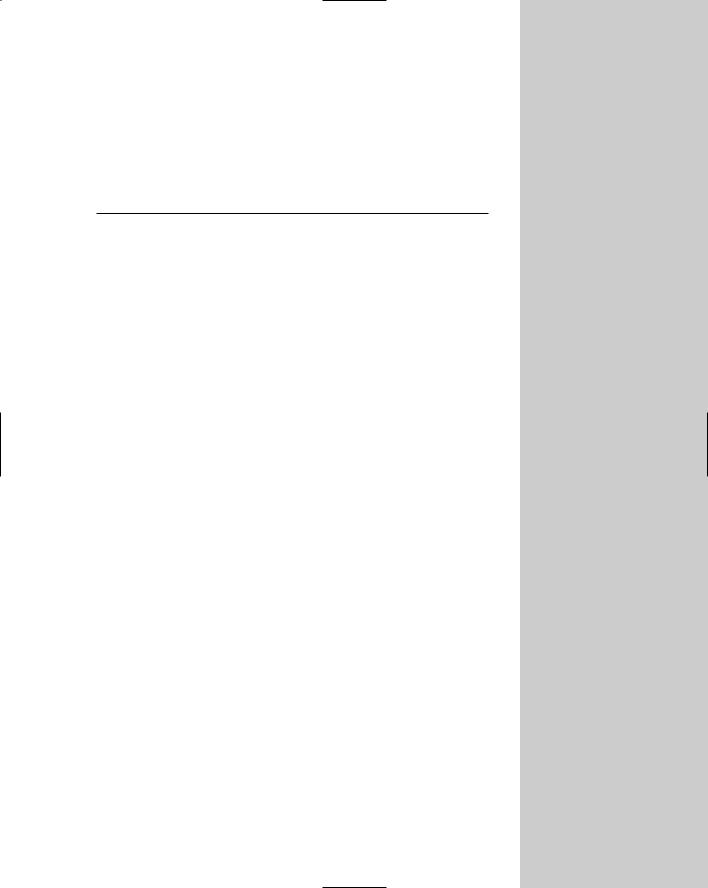
Using Atmospheric
Effects
In the real world, an environment of some kind surrounds all objects. The environment does much to set the ambiance of the
scene. For example, an animation set at night in the woods has a very different environment than one set at the horse races during the middle of the day. Max includes dialog boxes for setting the color, background images, and lighting environment; these features can help define your scene.
This chapter covers atmospheric effects, including the likes of clouds, fog, fire, and volume lights. These effects can be seen only when the scene is rendered.
Creating Atmospheric Effects
The Environment and Effects dialog box (keyboard shortcut, 8) contains rollouts for adding atmospheric effects to your scene, but the first question is where. Atmospheric effects are placed within a container called an Atmospheric Apparatus gizmo, which tells the effect where it should be located. However, only the Fire and the Volume Fog effects need Atmospheric Apparatus gizmos. To create an Atmospheric Apparatus gizmo, select Create Helpers Atmospherics and choose the apparatus type.
The three different Atmospheric Apparatus gizmos are BoxGizmo, SphereGizmo, and CylGizmo. Each of these has a different shape similar to the primitives.
Working with Atmospheric Apparatus
Selecting a gizmo and opening the Modify panel reveals two different rollouts: one for defining the basic parameters such as the gizmo dimensions, and another labeled Atmospheres & Effects, which you can use to Add or Delete an Environment Effect to the gizmo. Each gizmo parameters rollout also includes a Seed value and a New Seed button. The Seed value sets a random number used to compute the atmospheric effect, and the New Seed button automatically generates a random seed. Two gizmos with the same seed values have nearly identical results.
42C H A P T E R
In This Chapter
Using Atmospheric Apparatus gizmos to position atmospheric effects
Using the Fire effect
Working with fog
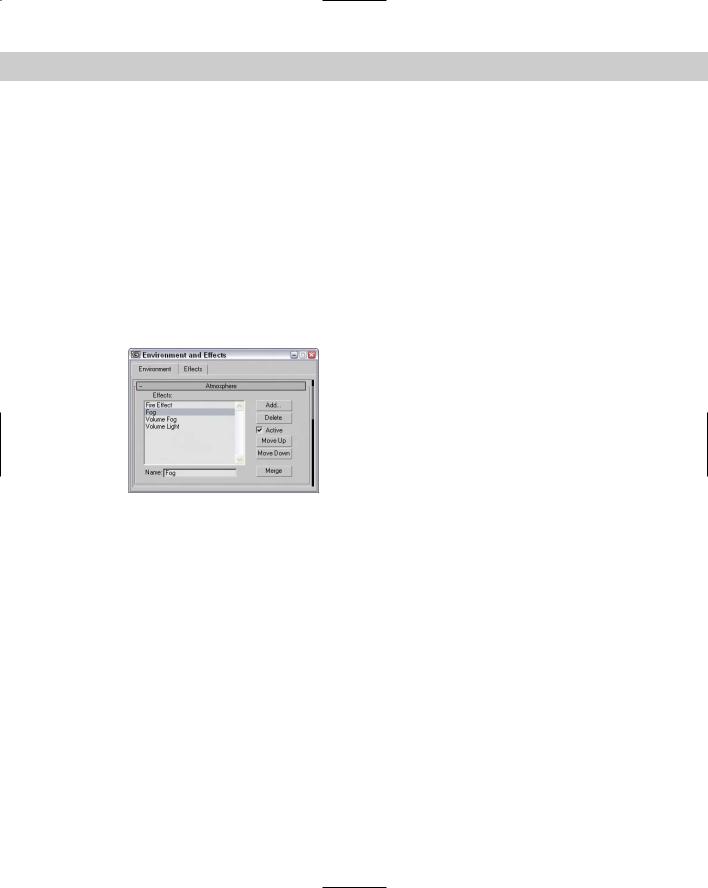
1006 Part X Rendering
Adding effects to a scene
The Add button opens the Add Atmosphere dialog box where you can select an atmospheric effect. The selected effect is then included in a list in the Atmospheres & Effects rollout. You can delete these atmospheres by selecting them from the list and clicking the Delete button. The Setup button is active if an effect is selected in the list. It opens the Environment and Effects dialog box. Adding Atmospheric Effects in the Modify panel is purely for convenience. They can also be added using the Environment and Effects dialog box.
In addition to the Modify panel, you can add atmospheric effects to the scene using the Atmosphere rollout in the Environment and Effects dialog box, shown in Figure 42-1. This rollout is pretty boring until you add an effect to it. You can add an effect by clicking on the Add button. This opens the Add Atmospheric Effect dialog box, which includes by default four atmospheric effects: Fire Effect, Fog, Volume Fog, and Volume Light. With plug-ins, you can increase the number of effects in this list. The effect that is selected is added to the Effects list in the Atmosphere rollout.
Figure 42-1: The Add Atmospheric Effect dialog box lets you select atmospheric effects.
You can delete an effect from the current Effects list in the Environment and Effects dialog box by selecting the effect and clicking the Delete button. The effects are applied in the order in which they are listed, so the effects at the bottom of the list are layered on top of all other effects. To the right of the Effects pane are the Move Up and Move Down buttons, used to position the effects in the list. Below the Effects pane is a Name field where you can type a new name for any effect in this field. This enables you to use the same effect multiple times. The Merge button opens the Merge Atmospheric Effects dialog box, where you can select a separate Max file. You can then select and load any render effects from the other file.
Using the Fire Effect
To add the Fire effect to the scene, click the Add button and select the Fire Effect selection. This opens the Fire Effect Parameters rollout, shown in Figure 42-2. At the top of the Fire Effect Parameters rollout is the Pick Gizmo button; clicking this button lets you select a gizmo in the scene. The selected gizmo appears in the drop-down list to the right. You can select multiple gizmos. To remove a gizmo from the list, select it and click the Remove Gizmo button.
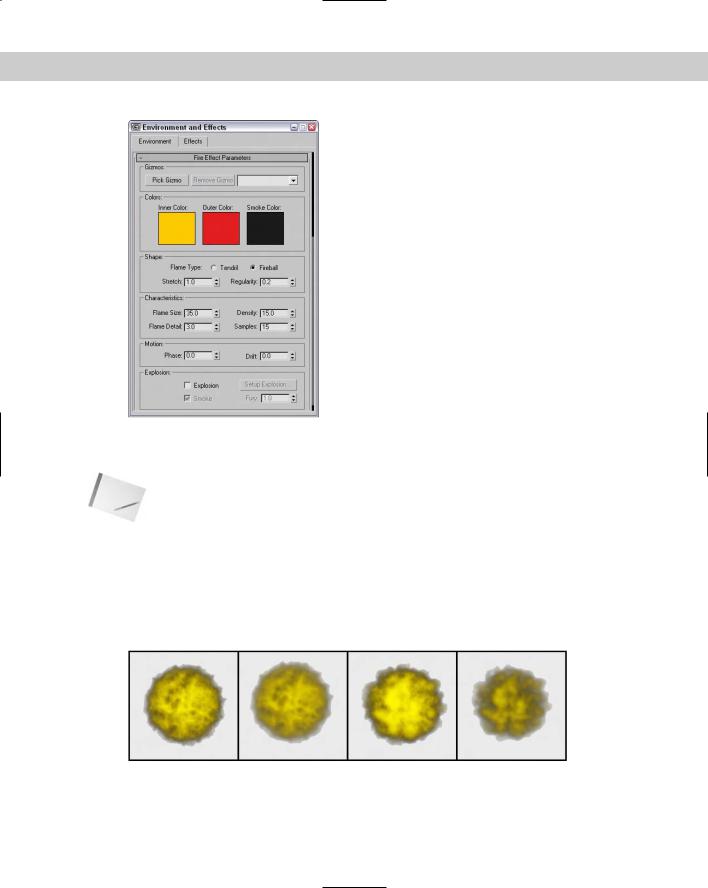
Chapter 42 Using Atmospheric Effects 1007
Figure 42-2: The Fire Effect Parameters rollout lets you define the look of the effect.
Note |
The Fire effect renders only in non-orthographic views such as Perspective or a camera view. |
The three color swatches define the color of the fire effect and include an Inner Color, an Outer Color, and a Smoke Color. The Smoke Color is used only when the Explosion option is set. The default red and yellow colors make fairly realistic fire.
The Shape section includes two Flame Type options: Tendril and Fireball. The Tendril shape produces veins of flames, and the Fireball shape is rounder and puffier. Figure 42-3 shows four fire effects. The left two have the Tendril shape, and the two on the right are set to Fireball. The difference is in the Density and Flame Detail settings.
Figure 42-3: The Fire atmospheric effect can be either Tendril or Fireball shaped.
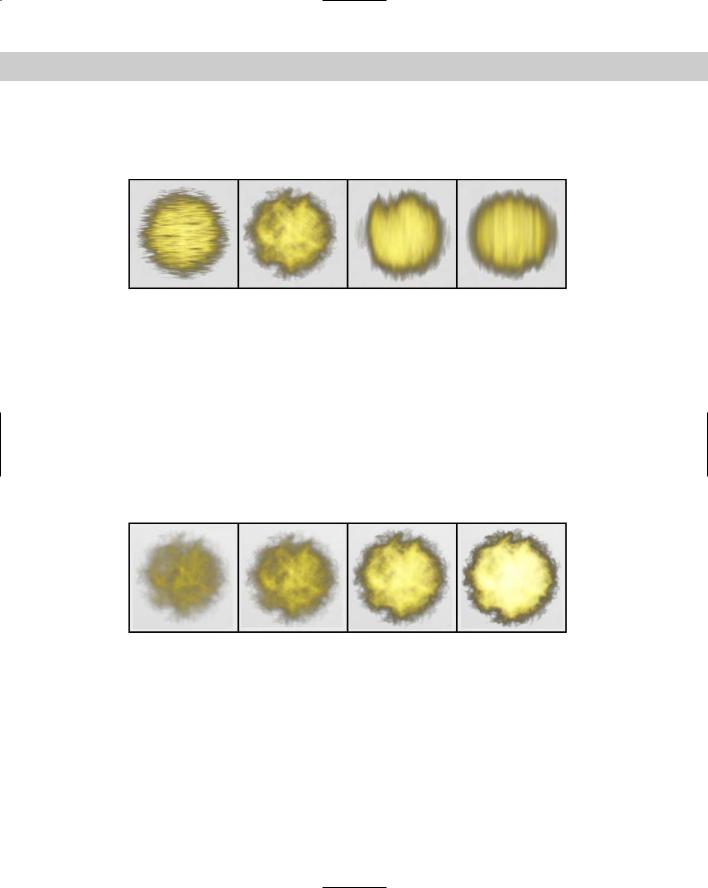
1008 Part X Rendering
The Stretch value elongates the individual flames along the gizmo’s Z axis. Figure 42-4 shows the results of using the Stretch value. The Stretch values for these gizmos, from left to right, are 0.1, 1.0, 5.0, and 50.
Figure 42-4: The Stretch value can elongate flames.
The Regularity value determines how much of the Atmospheric Apparatus is filled. The spherical gizmos in the previous figures were all set to 0.2, so the entire sphere shape wasn’t filled. A setting of 1.0 adds a spherical look to the Fire effect, because the entire gizmo is filled. For a more random shape, use a small Regularity value.
The Flame Size value affects the overall size of each individual flame (though this is dependent on the gizmo size as well). The Flame Detail value controls the edge sharpness of each flame and can range from 1 to 10. Lower values produce fuzzy, smooth flames, but higher values result in sharper, more distinct flames.
The Density value determines the thickness of each flame in its center; higher Density values result in flames that are brighter at the center, while lower values produce thinner, wispy flames. Figure 42-5 shows the difference caused by Density values of, from left to right, 10, 20, 50, and 100.
Figure 42-5: The Fire effect brightness is tied closely to the flame Density value.
The Samples value sets the rate at which the effect is sampled. Higher sample values are required for more detail, but they increase the render time.

Chapter 42 Using Atmospheric Effects 1009
The Motion section includes options for setting the Phase and Drift of a fire effect. The Phase value determines how wildly the fire burns. For a wild, out-of-control fire, animate the Phase value to change rapidly. For a constant, steady fire, keep the value constant throughout the frames. The Drift value sets the height of the flames. High Drift values produce high, hotburning flames.
The Explosion section lets you make a fire into an explosion. When the Explosion check box is selected, the fire is set to explode. The Start and End Times for the explosion are set in the Setup Explosion Phase Curve dialog box that opens when the Setup Explosion button is clicked. If the Smoke option is checked, then the fire colors change to the smoke color for Phase values between 100 and 200. The Fury value varies the churning of the flames. Values greater than 1.0 cause faster churning, and values lower than 1.0 cause slower churning.
Tutorial: Creating the sun
You can use the Fire effect to create a realistic sun. The modeling part is easy — all it requires is a simple sphere — but the real effects come from the materials and the Fire effect.
To create a sun, follow these steps:
1.Open the Sun.max file from the Chap 42 directory on the CD-ROM.
This file contains a simple sphere with a bright yellow material applied to it.
2.Select Create Helpers Atmospherics Sphere Gizmo and drag a sphere in the Front viewport that encompasses the “sun” sphere.
3.With the SphereGizmo still selected, open the Modify panel and click the Add button in the Atmospheres rollout. Select Fire Effect from the Add Atmospheres & Effects dialog box, and click OK. Then select the Fire effect, and click the Setup button.
The Environment and Effects dialog box opens.
4.In the Fire Effects Parameters rollout, set the Inner Color to yellow, the Outer Color to red, and the Smoke color to black (these are the default colors). For the Flame Type, select Tendril with Stretch and Regularity values of 1. Set the Flame Size to 30, the Density to 15, the Flame Detail to 10, and the Samples to 15.
Figure 42-6 shows the resulting sun after it’s been rendered.
Tutorial: Creating clouds
Sky images are fairly easy to find, or you can just take your camera outside and capture your own. The trick comes when you are trying to weave an object in and out of clouds. Although you can do this with a Shadow/Matte mask, it would be easier if the clouds were actual 3D objects. In this tutorial, we create some simple clouds using the Fire effect.
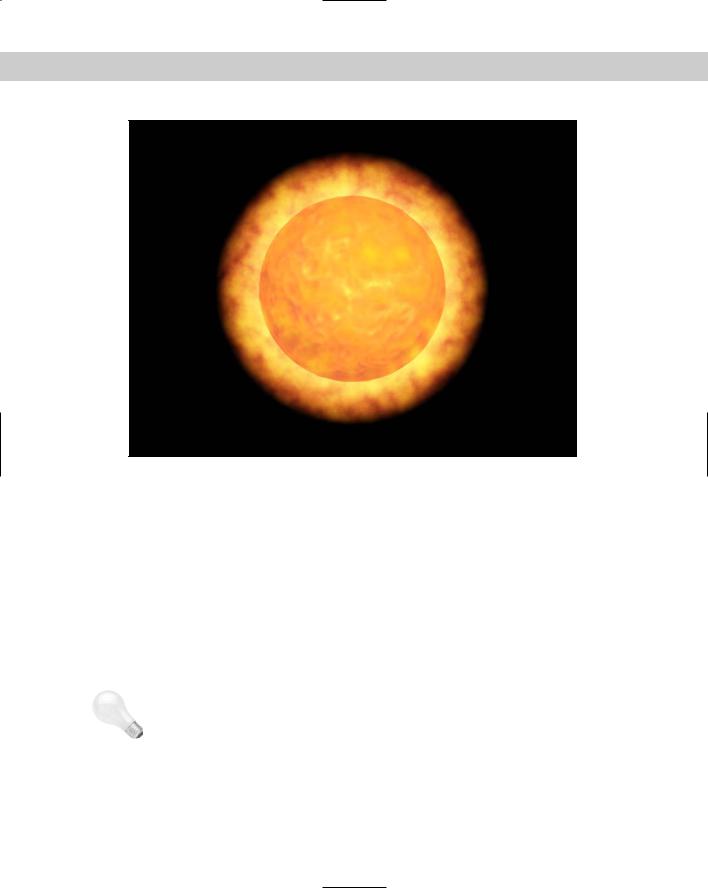
1010 Part X Rendering
Figure 42-6: A sun image created with a simple sphere, a material with a Noise Bump map, and the Fire effect.
To create some clouds for a sky backdrop, follow these steps:
1.Open the Clouds.max file from the Chap 42 directory on the CD-ROM.
This file includes several hemispherical-shaped atmospheric apparatus gizmos.
2.Choose Rendering Environment (or press the 8 key) to open the Environment and Effects dialog box. Click the Background Color swatch, and select a light blue color. In the Atmosphere section, click the Add button, select Fire Effect from the Add Atmospheric Effect list, and click OK.
3.Name the effect Clouds, and click each of the color swatches. Change the Inner Color to a dark gray, the Outer Color to a light gray, and the Smoke Color to white. Set the Shape to Fireball with a Stretch of 1 and a Regularity of 0.2. Set the Flame Size to 35, the Flame Detail to 3, the Density to 15, and the Samples to 15.
Tip |
If you want to add some motion to the clouds, click the Animate button, drag the Time Slider |
|
to the last frame, and change the Phase value to 45 and the Drift value to 30. The clouds |
|
slowly drift through the sky. Disable the Animate button when you’re finished. |
4.In the Fire Effect Parameters rollout, click the Pick Gizmo button and then click one of the gizmos in the viewports. Repeat this step until you’ve selected all the gizmos.
Figure 42-7 shows the resulting sky backdrop. By altering the Fire parameters, you can create different types of clouds.
